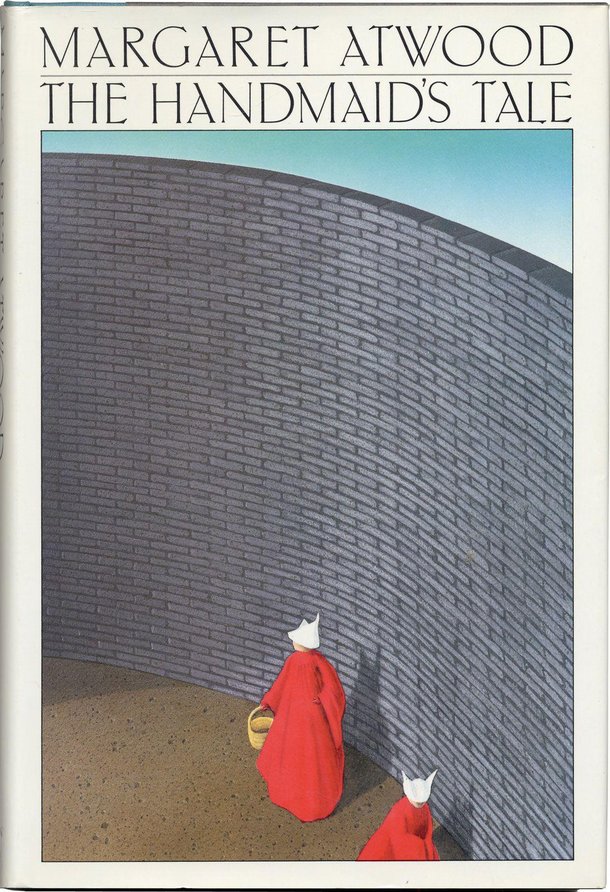A escritora canadense Margaret Atwood escreveu seu romance O Conto da Aia (The Handmaid’s Tale no original em inglês) em 1985. Na obra, ela imagina um futuro distópico que é ao mesmo tempo familiar e assustador. Nesta teocracia que foi instalada – a chamada República de Gileade — restaram poucas mulheres férteis, recrutadas para gerar os filhos da classe dominante.
Trata-se de uma obra fascinante que se revela, infelizmente, cada vez mais próxima do tempo que vivemos. Mas mesmo que você tenha visto todas as temporadas da série The Handmaid’s Tale, ainda há muito a aprender sobre o livro. Neste texto, contamos 5 fatos sobre ele.
1. O livro foi parcialmente inspirado na Alemanha durante a Guerra Fria

Os temas descritos por Margaret Atwood no livro foram parcialmente inspirados no fato de que a escritora vivia em 1984 na Alemanha, no auge da Guerra Fria. A escritora vivia no lado ocidental de Berlim, que ainda estava cercada pelo Muro de Berlim.
A partir de suas visitas a vários países da Cortina de Ferro, Atwood começou a pegar ideias e dar forma para a República de Gileade. “Eu experimentei a cautela, a sensação de estar sendo espionado, os silêncios, as mudanças de assunto, as maneiras oblíquas pelas quais as pessoas podem transmitir informações, e isso influenciou o que eu estava escrevendo”, declarou a escritora para o The New York Times.
2. O livro foi todo escrito à mão

Margaret Atwood escreveu O Conto da Aia em 1984, no mesmo ano em que a Apple lançou o seu primeiro modelo de Macintosh. Ainda assim, ela usou o método antigo: escreveu todo o livro à mão em blocos de papel amarelos. Só depois que terminou que ela o transcreveu em uma máquina de escrever alugada.
3. Atwood dedicou o livro para Mary Webster, considerada bruxa

O livro tem uma dedicatória a Mary Webster, uma moradora da cidade puritana de Hadley, Massachusetts – e que, segundo a tia de Margaret Atwood, seria uma ancestral sua. Em 1683, Mary Webster foi levada a julgamento por um suposto crime de bruxaria, mas foi inocentada. No ano seguinte, um sujeito chamado Philip Smith estava morrendo e decidiu que Webster era a culpada pelo sofrimento que o acometia.
Por consequência, os cidadãos da cidade resolveram matá-la. Eles tentaram enforcá-la, deixando-a pendurada durante a noite toda. Mas, quando voltaram pela manhã, ela ainda estava viva. O acidente rendeu a ela o apelido de Half Hanged Mary.O Conto da Aia foi dedicado à memória dela.
4. Atwood não considera que o livro seja de ficção científica

Boa parte da crítica categoriza os livros de Margaret Atwood, incluindo O Conto da Aia, como sendo de ficção científica, mas ela não concorda com este rótulo. Seu argumento é que muito do que é descrito no livro já acontece no mundo de alguma forma. Atwood sempre afirmou que a República de Gilead pode acontecer a qualquer momento.
5. O romance tem outras adaptações além da série

É bem possível que você tenha conhecido essa história a partir da série The Handmaid’s Tale, da Hulu. Mas esta não é a primeira nem a única adaptação do livro. Uma montagem teatral foi feita em 1989, na Tufts University em Medford, Massachusetts, poucos anos depois do lançamento da obra. Já em 2018 a montagem retornou aos palcos de Boston.
Além disso, também houve uma ópera, um balé, um programa de rádio e até um filme de 1990, estrelado por Natasha Richardson e Faye Dunaway. No Brasil, o filme foi lançado com o nome de A Decadência de uma Espécie.
Fonte: MegaCurioso.